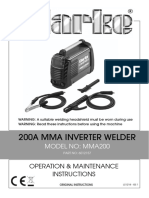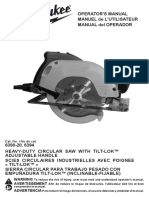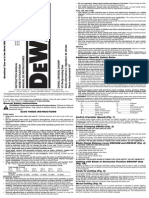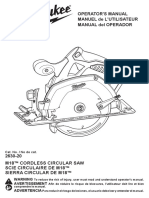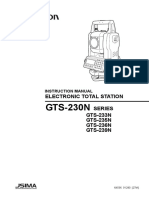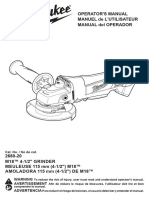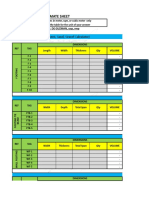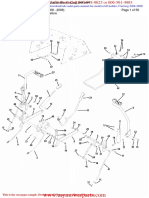2jack Hammer Instruction
2jack Hammer Instruction
Uploaded by
SimjanCopyright:
Available Formats
2jack Hammer Instruction
2jack Hammer Instruction
Uploaded by
SimjanOriginal Title
Copyright
Available Formats
Share this document
Did you find this document useful?
Is this content inappropriate?
Copyright:
Available Formats
2jack Hammer Instruction
2jack Hammer Instruction
Uploaded by
SimjanCopyright:
Available Formats
Jack Hammer
Introduction
Demolition hammers are tools which are designed
to be utilized in demolition. They are typically
heavy and powerful so that they can be used to
break up a variety of substances, from wooden
walls to concrete pads, and they are an important
part of the tool arsenal for a construction crew.
There are a number of types of demolition
hammer on the market, ranging from simple
models used in do-it-yourself projects to more
heavy-duty versions for industrial demolition. This
module discusses about electric and portable jack hammers (petrol type).
Risk and Hazards
Wear ear protectors. Exposure to noise can cause hearing loss.
Wear a hard hat (safety helmet), safety glasses and/or face shield. It is
also highly recommended that you wear a dust mask, ear protectors and
thickly padded gloves.
Keep hands away from moving parts.
When chipping into walls, floors or wherever live electrical wires may be
encountered, do not touch any metal part of the tool.
Hold the tool by the insulated grasping surfaces to prevent electric shock if
you chip into a live wire.
High temperature of moving parts after operation; this could cause skin
burns if touched.
Some material contains chemicals which may be toxic. Take caution to
prevent dust inhalation and skin contact. Follow material supplier safety
data.
Location Considerations
Keep work area clean and well lit. Cluttered and dark areas invite accidents.
Do not operate power tools in explosive atmospheres, such as in the presence of
flammable liquids, gases or dust. Power tools create sparks which may ignite the
dust or fumes.
Keep children and bystanders away while operating a power tool. Distractions
can cause you to lose control.
Pre Operational Safety
Before starting your work at your chosen area, you should do a hazard
identification and risk control precautions.
Inspect your work place.
Know the best way to do the job. Follow the procedures.
Review the Safe wok information supplied with the equipment.
Copyright 2010 OnGuard Safety Training PTY LTD 1
Wear the appropriate and close fitting clothing. Long hair must be tied.
Ensure to wear the proper PPE; safety goggles, ear muffs, safety boots,
helmet, etc.
Ensure all guards are properly in place.
Due to normal operation, the tool is designed to create vibrations. The
screws can come loose easily, causing a breakdown or an accident.
Check tightness of screws carefully before starting to operate the tool.
Ensure that your power outlet is protected by an RCD (Residual Current
Device) safety switch.
Use of the demolition hammer will cause collapse of structure in some
applications. Installation of approved shoring or suitable controls is
required.
Operating Safety
When using any tool or equipment, do not over reach.
Ensure that you have firm footing and are always ready to handle any
reaction the equipment may make.
Do not point the tool at any one in the area when operating. The bit could
fly out and injure someone seriously.
Do not touch the bit or parts close to the bit immediately after operation;
they may be extremely hot and could burn your skin.
Do check controls and any safety device for proper response.
Do not operate the tool if you are tired or suffering any medical condition.
Do not hurry and take risks.
For the petrol type:
Use extreme care when filling fuel tanks-vapours ca be explosive.
Ensure that the motor is switched off when filling.
Keep fuel containers at least 3 meters away from where you will be
starting the equipment.
Ensure that fuel cannot come in contact with the hot engine parts such as
the exhaust.
Keep sources of sparks away from any flammable liquid.
Where possible, keep appropriate fire extinguishers nearby during
operations utilizing flammable liquids.
For the electric type:
Ensure that any electric equipment or extension lead that you are using
has been electrically tested, tagged, and dated by a competent person
within the last 3 months.
If you are to use electrical extension leads, make sure that it is no longer
than 15 meters as it causes a significant voltage drop, potentially
compromising personal safety and leading to possible equipment damage.
Maintenance
Always be sure that the tool is switched off and unplugged before attempting to
perform inspection or maintenance.
Copyright 2010 OnGuard Safety Training PTY LTD 2
Replacement of carbon brushes
Whenever carbon brushes must be replaced, they cut out the tool
automatically. When this occurs, remove the holder cap plates and then
replace both carbon brushes at the same time. Use only identical carbon
brushes.
Lubrication
Lubricate the tool every time the carbon brushes are replaced.
Operating Procedures
Always be sure that the unit is switched off and unplugged before
installing or removing the bit.
Do not leave the tool running. Operate the tool only when hand-held.
Do not operate the tool at no-load unnecessarily.
Install the grips securely with the bolts using the proper tool which is a hex
wrench.
Before plugging in the tool, always check to see that the switch returns to
the OFF position when released.
Do not tape, tie or fix the switch lever in the On position. To start the
tool, simply squeeze the lever. Release the switch to stop.
For chipping/scaling or demolition, hold the tool firmly with both hands.
Turn the tool on and apply slight pressure on the tool so that it will not
bounce around uncontrolled. Pressing very hard will not increase
efficiency.
Copyright 2010 OnGuard Safety Training PTY LTD 3
You might also like
- Audi 0B5 TPI 2039534 - Repair Instructions (By Keldo)Document9 pagesAudi 0B5 TPI 2039534 - Repair Instructions (By Keldo)Keldo Gliana100% (3)
- 6th Central Pay Commission Salary CalculatorDocument15 pages6th Central Pay Commission Salary Calculatorrakhonde100% (436)
- Service Manual Ricoh AficioDocument448 pagesService Manual Ricoh Aficiodaltontech14% (7)
- 06.013 Canopy Inspection Check List v2Document9 pages06.013 Canopy Inspection Check List v2SimjanNo ratings yet
- Model W210 Electric Seat AdjustmentDocument29 pagesModel W210 Electric Seat AdjustmentNacho100% (2)
- Rain Detector Project ProposalDocument4 pagesRain Detector Project ProposalI Am Tera Baap Khan90% (10)
- Dewalt DW433 SanderDocument6 pagesDewalt DW433 SanderRichard SmithNo ratings yet
- Tools and Equipment SafetyDocument48 pagesTools and Equipment SafetyChristian Arthur RevaloNo ratings yet
- OSHA 30 Power Tool Safety Study GuideDocument2 pagesOSHA 30 Power Tool Safety Study GuideAbby McCollumNo ratings yet
- Fischer Technical Services Safety ManualDocument15 pagesFischer Technical Services Safety ManualHenry FlorendoNo ratings yet
- Hand and Power ToolsDocument38 pagesHand and Power ToolsMd shadab AkhterNo ratings yet
- General SafetyDocument32 pagesGeneral SafetyLancel AlcantaraNo ratings yet
- Ii:Rrftsmrn'I: Operator'S ManualDocument26 pagesIi:Rrftsmrn'I: Operator'S Manualzoryan1No ratings yet
- Black&Decker 3" X 21" Dragster Belt SanderDocument6 pagesBlack&Decker 3" X 21" Dragster Belt SanderwdowiuueNo ratings yet
- 12dada9219d4f7420c27388bfd834b1db2f716a79cebb9f0f53adbb825684e3f_optimDocument10 pages12dada9219d4f7420c27388bfd834b1db2f716a79cebb9f0f53adbb825684e3f_optimgerardotomasrodriguezprevostNo ratings yet
- GSS160 OmDocument48 pagesGSS160 OmMauricio Soto AguirreNo ratings yet
- Power Tools SafetyDocument50 pagesPower Tools SafetyRonald MedranoNo ratings yet
- TOOLS AND EQUIPMENT deDocument26 pagesTOOLS AND EQUIPMENT detonychopper1031No ratings yet
- Black and Decker PS1440 DrillDocument6 pagesBlack and Decker PS1440 Drillrda1978No ratings yet
- dw384 Manual PDFDocument7 pagesdw384 Manual PDFEfrain KaracNo ratings yet
- 328494-01, DW678 DW677 ManualDocument27 pages328494-01, DW678 DW677 ManualBladi GpNo ratings yet
- Black Decker PD600 ScrewdriverDocument6 pagesBlack Decker PD600 ScrewdriverPrime MacawNo ratings yet
- 200A Mma Inverter Welder: Operation & Maintenance InstructionsDocument20 pages200A Mma Inverter Welder: Operation & Maintenance InstructionsMobin MkNo ratings yet
- Instruction Manual Manual de Instrucciones Manual de Instruções Angle Grinder Esmeriladora Angular Esmerilhadeira AngularDocument12 pagesInstruction Manual Manual de Instrucciones Manual de Instruções Angle Grinder Esmeriladora Angular Esmerilhadeira Angular_blackmore_No ratings yet
- Craftman Power Saw ManualDocument29 pagesCraftman Power Saw ManualTrevor GarveyNo ratings yet
- Manual Sierra B&DDocument56 pagesManual Sierra B&DLadislao ChavezNo ratings yet
- Safety First HandbookDocument15 pagesSafety First Handbookimranjamal3009No ratings yet
- Ricoh DD 6650 Service ManualDocument386 pagesRicoh DD 6650 Service Manualmaysara-slahNo ratings yet
- pt-d4 FSM en Final 090615 PDFDocument208 pagespt-d4 FSM en Final 090615 PDFWilliam LozadaNo ratings yet
- 2022 Power Tools (BSME)Document26 pages2022 Power Tools (BSME)kkiyo2113No ratings yet
- r00021v-1 r18736v2 Die Grinder ManualDocument24 pagesr00021v-1 r18736v2 Die Grinder ManualsanprojectNo ratings yet
- 4719 Robot Mower Manual Aw3Document32 pages4719 Robot Mower Manual Aw3silviuNo ratings yet
- 4-1/2in. Angle Grinder: Owner'S ManualDocument14 pages4-1/2in. Angle Grinder: Owner'S ManualboomissyNo ratings yet
- Especificaciones TOPCON CTS-3007Document192 pagesEspecificaciones TOPCON CTS-3007Miguel Angel Ramirez FarfanNo ratings yet
- Manual Amoladora Inalámbrica Milwaukee M18 FuelDocument28 pagesManual Amoladora Inalámbrica Milwaukee M18 FuelDiego Andrés Bermúdez NiñoNo ratings yet
- TLE-EIM Grade9 Module Quarter1 Week3and4Document11 pagesTLE-EIM Grade9 Module Quarter1 Week3and4Renzo zorillaNo ratings yet
- Aficio SP C430DN Series Field Service ManualDocument674 pagesAficio SP C430DN Series Field Service ManualMartinNo ratings yet
- Sierra CirculaDocument32 pagesSierra CirculaMaritza HernandezNo ratings yet
- Warning Avertissement Advertencia: Cat. No. / No de CatDocument36 pagesWarning Avertissement Advertencia: Cat. No. / No de Catchris CruzNo ratings yet
- Service ManualDocument1,008 pagesService ManualLuis OsorioNo ratings yet
- Model Pro C901S/Pro C901 Machine Code: D095/M077 Field Service ManualDocument20 pagesModel Pro C901S/Pro C901 Machine Code: D095/M077 Field Service ManualMoamen GalalNo ratings yet
- Ricoh Pro c901Document1,642 pagesRicoh Pro c901djouldeoNo ratings yet
- Greenworks 21142 Power Head Manual EDocument24 pagesGreenworks 21142 Power Head Manual ETim EvansNo ratings yet
- Operator'S Manual Manuel de L'Utilisateur Manual Del OperadorDocument13 pagesOperator'S Manual Manuel de L'Utilisateur Manual Del Operadornvh2nhgztmNo ratings yet
- DW304PK ManualDocument5 pagesDW304PK ManualvinodkareerNo ratings yet
- Operator'S Manual Manuel de L'Utilisateur Manual Del OperadorDocument24 pagesOperator'S Manual Manuel de L'Utilisateur Manual Del OperadorfdonyNo ratings yet
- Work Safely With Portable Power Tools: T T T S - N - 25Document2 pagesWork Safely With Portable Power Tools: T T T S - N - 25joysvcNo ratings yet
- SG3120B SFNW Field Service Manual-WebDocument444 pagesSG3120B SFNW Field Service Manual-Webprint press (printpress.eg)No ratings yet
- DD4450 Service ManualDocument240 pagesDD4450 Service ManualServnetTechnicianNo ratings yet
- WARNING! Read and Understand All Instructions. Failure To Follow All InstrucDocument5 pagesWARNING! Read and Understand All Instructions. Failure To Follow All InstruciconoclasticjarheadNo ratings yet
- PDFDocument19 pagesPDFPsiNo ratings yet
- 34' Hex Demolition Hammer 5337-20Document28 pages34' Hex Demolition Hammer 5337-201092 hanna (primary soul)No ratings yet
- Jig Saw ManualDocument5 pagesJig Saw ManualВлад КубовNo ratings yet
- Operator'S Manual Manuel de L'Utilisateur Manual Del OperadorDocument24 pagesOperator'S Manual Manuel de L'Utilisateur Manual Del Operadord sNo ratings yet
- GTS-230N - Instruction Manual - Eng - 27MDocument184 pagesGTS-230N - Instruction Manual - Eng - 27MJAMES RITCHIE ANAK ROGERNo ratings yet
- Manual Policorte CompletoDocument36 pagesManual Policorte CompletoDivino CésarNo ratings yet
- Operator'S Manual Manuel de L'Utilisateur Manual Del OperadorDocument20 pagesOperator'S Manual Manuel de L'Utilisateur Manual Del Operadorbmatthew1111No ratings yet
- milwaukee-MXF370-2XC-user GuideDocument20 pagesmilwaukee-MXF370-2XC-user GuideAyrin SanNo ratings yet
- 58-14-6477d7 Circular Saw Manual Usuario MilwaukeeDocument40 pages58-14-6477d7 Circular Saw Manual Usuario MilwaukeeRicardo MedranoNo ratings yet
- Operator'S Manual Manuel de L'Utilisateur Manual Del OperadorDocument28 pagesOperator'S Manual Manuel de L'Utilisateur Manual Del OperadorJunky mikeNo ratings yet
- Power Tools Safety GuidelinesDocument2 pagesPower Tools Safety GuidelinesShailendraNo ratings yet
- MPC 305 Service ManualDocument1,102 pagesMPC 305 Service ManualFudzo LodzaNo ratings yet
- 1-Hand Power Tools - SafetyDocument69 pages1-Hand Power Tools - SafetynbvillarazoNo ratings yet
- Ultimate Guide: Barns, Sheds & Outbuildings, Updated 4th Edition: Step-by-Step Building and Design Instructions Plus Plans to Build More Than 100 OutbuildingsFrom EverandUltimate Guide: Barns, Sheds & Outbuildings, Updated 4th Edition: Step-by-Step Building and Design Instructions Plus Plans to Build More Than 100 OutbuildingsRating: 3 out of 5 stars3/5 (1)
- Full Truss Diagram (Ft1)Document1 pageFull Truss Diagram (Ft1)SimjanNo ratings yet
- Sample FSDocument1 pageSample FSSimjanNo ratings yet
- Ground Floor Tile Layout Second Floor Tile Layout: 300MM X 300MM Floor Tiles DN 600MM X 600MM Floor TilesDocument1 pageGround Floor Tile Layout Second Floor Tile Layout: 300MM X 300MM Floor Tiles DN 600MM X 600MM Floor TilesSimjanNo ratings yet
- Ground Floor Plan Second Floor Plan Roof Plan: Bedroom 01 DN T&B KitchenDocument1 pageGround Floor Plan Second Floor Plan Roof Plan: Bedroom 01 DN T&B KitchenSimjanNo ratings yet
- Front Elevation Right-Side Elevation Cross SectionDocument1 pageFront Elevation Right-Side Elevation Cross SectionSimjanNo ratings yet
- 0317 All-New 2021 Hyundai Elantra and Elantra Hybrid Make World Premiere in Hollywood - FINALDocument13 pages0317 All-New 2021 Hyundai Elantra and Elantra Hybrid Make World Premiere in Hollywood - FINALSimjanNo ratings yet
- C1F1 C1F2 C2F1 Ftb1 B1 B1: Foundation Plan 2Nd Floor Framing PlanDocument1 pageC1F1 C1F2 C2F1 Ftb1 B1 B1: Foundation Plan 2Nd Floor Framing PlanSimjanNo ratings yet
- Table of Contents in Science 11Document6 pagesTable of Contents in Science 11SimjanNo ratings yet
- Eset Nod32 KeysDocument2 pagesEset Nod32 KeysSimjanNo ratings yet
- Boq Estimator Edition-3Document10 pagesBoq Estimator Edition-3SimjanNo ratings yet
- Process/Safety-Relief Valve-Flanged: Consolidated 1900Document5 pagesProcess/Safety-Relief Valve-Flanged: Consolidated 1900Limber JairNo ratings yet
- Science Project-Pinhole CameraDocument9 pagesScience Project-Pinhole CameraHaleema GulNo ratings yet
- Ejector, Series EBS: Technical DataDocument8 pagesEjector, Series EBS: Technical DataDobos LászlóNo ratings yet
- Parts Catalogue For Pramac gx1020 - v1Document20 pagesParts Catalogue For Pramac gx1020 - v1PetrNo ratings yet
- Table Saw ManualDocument56 pagesTable Saw ManualTerry HillNo ratings yet
- Industrial Brake Catalogue - Web 1Document15 pagesIndustrial Brake Catalogue - Web 1ashraf elsayedNo ratings yet
- NM Half Inch Connector Preparation InstructionsDocument2 pagesNM Half Inch Connector Preparation Instructionssandeep bagulNo ratings yet
- TM 9-6625-2150-34P - TEK - 7613 - Mainframe - 1986 PDFDocument147 pagesTM 9-6625-2150-34P - TEK - 7613 - Mainframe - 1986 PDFWurzel1946No ratings yet
- Reversible Ceiling Fan 1400mm - Anda ProductsDocument2 pagesReversible Ceiling Fan 1400mm - Anda ProductsSuzenne Jyn MendozaNo ratings yet
- Heavy Duty Tablesaw By: InvictaDocument23 pagesHeavy Duty Tablesaw By: InvictaReniê ÁvilaNo ratings yet
- Data Sheet - : Firemiks® FM 6000-Rp-FDocument3 pagesData Sheet - : Firemiks® FM 6000-Rp-Fzepol051No ratings yet
- Digital Temperature Controller W1209 (Temperature - 50 To +110 Celsius) W - 20A Relay - QQ Online TradingDocument3 pagesDigital Temperature Controller W1209 (Temperature - 50 To +110 Celsius) W - 20A Relay - QQ Online TradingJose Enrique SantamariaNo ratings yet
- G Retrievable Packer Technical DatasheetDocument3 pagesG Retrievable Packer Technical DatasheetEvolution Oil ToolsNo ratings yet
- Kenr8662kenr8662 Sis PDFDocument2 pagesKenr8662kenr8662 Sis PDFKelvin FaneyteNo ratings yet
- Usage:: TolerancesDocument35 pagesUsage:: TolerancesАндрейNo ratings yet
- Color Coding SchemeDocument20 pagesColor Coding SchemeDiorella PaguioNo ratings yet
- Core 5Document9 pagesCore 5eleno m. estoqueNo ratings yet
- NS1000 50Document28 pagesNS1000 50moh taNo ratings yet
- BW Bema 20-25 EnglischDocument16 pagesBW Bema 20-25 EnglischDaniel PricopNo ratings yet
- Cub Cadet Parts Manual For Model Rzt42 Kohler 17ae2acg 2008 2009Document5 pagesCub Cadet Parts Manual For Model Rzt42 Kohler 17ae2acg 2008 2009joan100% (61)
- Electrical ToolsDocument5 pagesElectrical ToolsANTHONY JAY QUINTERONo ratings yet
- BMW E30 Sunroof Repair - PDF - Brian David BernardDocument3 pagesBMW E30 Sunroof Repair - PDF - Brian David BernardEd MoralesNo ratings yet
- ML - Valve ActuatorDocument8 pagesML - Valve ActuatorGabrielNo ratings yet
- 1 Kursi 9 Standing Ac: NO Nama Barang Harga No Nama Barang HargaDocument3 pages1 Kursi 9 Standing Ac: NO Nama Barang Harga No Nama Barang HargamamanNo ratings yet
- 2019 StreamLine BRO040919webDocument8 pages2019 StreamLine BRO040919webAlexis Rodrigo Tapia EstrellaNo ratings yet
- Input Diode and Output Transistor Check Procedure On A Variable Frequency Drive (VFD) With Short VideoDocument5 pagesInput Diode and Output Transistor Check Procedure On A Variable Frequency Drive (VFD) With Short VideoYamilNo ratings yet
- Manual - EN - ES6 - Parts - 02250173-919 R00 - 20090129 - BXTDocument64 pagesManual - EN - ES6 - Parts - 02250173-919 R00 - 20090129 - BXTMantenimiento General CMHNo ratings yet






















